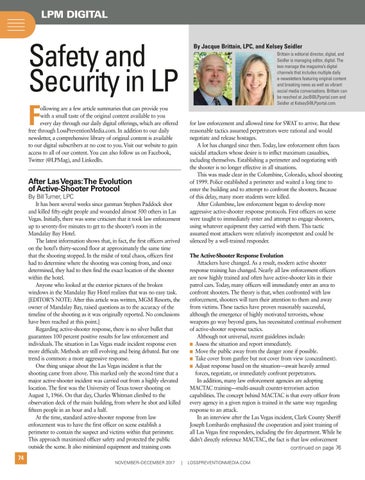LPM DIGITAL
Safety and Security in LP
By Jacque Brittain, LPC, and Kelsey Seidler Brittain is editorial director, digital, and Seidler is managing editor, digital. The two manage the magazine’s digital channels that includes multiple daily e-newsletters featuring original content and breaking news as well as vibrant social media conversations. Brittain can be reached at JacB@LPportal.com and Seidler at KelseyS@LPportal.com.
F
ollowing are a few article summaries that can provide you with a small taste of the original content available to you every day through our daily digital offerings, which are offered free through LossPreventionMedia.com. In addition to our daily newsletter, a comprehensive library of original content is available to our digital subscribers at no cost to you. Visit our website to gain access to all of our content. You can also follow us on Facebook, Twitter (@LPMag), and LinkedIn.
for law enforcement and allowed time for SWAT to arrive. But these reasonable tactics assumed perpetrators were rational and would negotiate and release hostages. A lot has changed since then. Today, law enforcement often faces suicidal attackers whose desire is to inflict maximum casualties, including themselves. Establishing a perimeter and negotiating with the shooter is no longer effective in all situations. This was made clear in the Columbine, Colorado, school shooting of 1999. Police established a perimeter and waited a long time to enter the building and to attempt to confront the shooters. Because of this delay, many more students were killed. After Columbine, law enforcement began to develop more aggressive active-shooter response protocols. First officers on scene were taught to immediately enter and attempt to engage shooters, using whatever equipment they carried with them. This tactic assumed most attackers were relatively incompetent and could be silenced by a well-trained responder.
After Las Vegas: The Evolution of Active-Shooter Protocol By Bill Turner, LPC
It has been several weeks since gunman Stephen Paddock shot and killed fifty-eight people and wounded almost 500 others in Las Vegas. Initially, there was some criticism that it took law enforcement up to seventy-five minutes to get to the shooter’s room in the Mandalay Bay Hotel. The latest information shows that, in fact, the first officers arrived on the hotel’s thirty-second floor at approximately the same time that the shooting stopped. In the midst of total chaos, officers first had to determine where the shooting was coming from, and once determined, they had to then find the exact location of the shooter within the hotel. Anyone who looked at the exterior pictures of the broken windows in the Mandalay Bay Hotel realizes that was no easy task. [EDITOR’S NOTE: After this article was written, MGM Resorts, the owner of Mandalay Bay, raised questions as to the accuracy of the timeline of the shooting as it was originally reported. No conclusions have been reached at this point.] Regarding active-shooter response, there is no silver bullet that guarantees 100 percent positive results for law enforcement and individuals. The situation in Las Vegas made incident response even more difficult. Methods are still evolving and being debated. But one trend is common: a more aggressive response. One thing unique about the Las Vegas incident is that the shooting came from above. This marked only the second time that a major active-shooter incident was carried out from a highly elevated location. The first was the University of Texas tower shooting on August 1, 1966. On that day, Charles Whitman climbed to the observation deck of the main building, from where he shot and killed fifteen people in an hour and a half. At the time, standard active-shooter response from law enforcement was to have the first officer on scene establish a perimeter to contain the suspect and victims within that perimeter. This approach maximized officer safety and protected the public outside the scene. It also minimized equipment and training costs
74
LPM 1117-D.indd 74
NOVEMBER–DECEMBER 2017
The Active-Shooter Response Evolution Attackers have changed. As a result, modern active shooter response training has changed. Nearly all law enforcement officers are now highly trained and often have active-shooter kits in their patrol cars. Today, many officers will immediately enter an area to confront shooters. The theory is that, when confronted with law enforcement, shooters will turn their attention to them and away from victims. These tactics have proven reasonably successful, although the emergence of highly motivated terrorists, whose weapons go way beyond guns, has necessitated continual evolvement of active-shooter response tactics. Although not universal, recent guidelines include: ■ Assess the situation and report immediately. ■ Move the public away from the danger zone if possible. ■ Take cover from gunfire but not cover from view (concealment). ■ Adjust response based on the situation—await heavily armed forces, negotiate, or immediately confront perpetrators. In addition, many law enforcement agencies are adopting MACTAC training—multi-assault counter-terrorism action capabilities. The concept behind MACTAC is that every officer from every agency in a given region is trained in the same way regarding response to an attack. In an interview after the Las Vegas incident, Clark County Sheriff Joseph Lombardo emphasized the cooperation and joint training of all Las Vegas first responders, including the fire department. While he didn’t directly reference MACTAC, the fact is that law enforcement continued on page 76 |
LOSSPREVENTIONMEDIA.COM
11/13/17 10:01 AM







